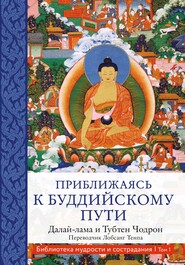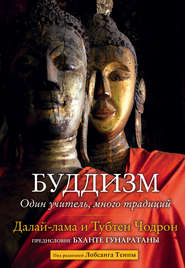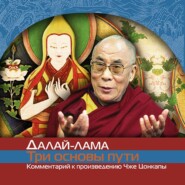По всем вопросам обращайтесь на: info@litportal.ru
(©) 2003-2024.
✖
The Four Noble Truths
Автор
Год написания книги
2018
Настройки чтения
Размер шрифта
Высота строк
Поля
However, when we talk about Taking Refuge in the Three Jewels, we should not imagine that it simply involves a ceremony in which we formally take Refuge from a master, or that merely by virtue of participating in such a ceremony we have become a Buddhist. There is a formal Refuge ceremony in Buddhism, but the ceremony is not the point. The point is that as a result of your own reflection, even without a master, you become fully convinced of the validity of the Buddha, Dharma and Sangha as the true ultimate objects of refuge, and that is when you actually become a Buddhist. You entrust your spiritual wellbeing to the Three Jewels, and this is what is really meant by Taking Refuge. On the other hand, if there is any doubt or apprehension in your mind about the validity of Buddha, Dharma and Sangha as being the ultimate objects of refuge, even though you may have taken part in a Refuge ceremony, that very suspicion or doubt prevents you from being a practising Buddhist, at least for the time being. It is therefore important to understand what these objects of refuge are.
When we speak about Buddha in this context, we should not confine our understanding of the word to the historical person who came to India and taught a certain spiritual way of life. Rather, our understanding of buddhahood
(#litres_trial_promo) should be based on levels of consciousness, or levels of spiritual realization. We should understand that buddhahood is a spiritual state of being. This is why the Buddhist scriptures can speak about past buddhas, buddhas of the present and buddhas of the future.
Now the next question is: how does a buddha come into being? How does a person become fully enlightened? When we reflect on buddhahood, we are bound to ask ourselves whether or not it is possible for an individual to attain such a state, to become a fully enlightened being, a buddha. Here we find that the key lies in understanding the nature of Dharma. If the Dharma exists, then the Sangha will certainly exist – the Sangha are those who have engaged in the path of the Dharma, and who have realized and actualized its truth. If there are Sangha members who have reached spiritual states where they have overcome at least the gross levels of negativity and afflictive emotions, then we can envision the possibility of attaining a freedom from negativity and afflictive emotions which is total. That state is what we call buddhahood.
In the present context, I think we must make a distinction between the use of ‘Dharma’ as a generic term and its use in the specific framework of the Refuge. Generically, it refers to the scriptural Dharma – the Buddha’s teaching and the spiritual realizations based on the practice of that teaching. In relation to the Refuge it has two aspects: one is the path that leads to the cessation of suffering and afflictive emotions, and the other is cessation
(#litres_trial_promo) itself. It is only by understanding true cessation and the path leading to cessation that we can have some idea of what the state of liberation is.
Dependent Origination
In the Sutras, Buddha stated several times that whoever perceives the interdependent nature of reality sees the Dharma; and whoever sees the Dharma sees the Buddha.
(#litres_trial_promo) It is my belief that if we approach this statement from the perspective of Nagarjuna’s teachings of the Madhyamaka School, we can arrive at the most comprehensive understanding of its implications. If you were to accuse me of having a bias in favour of Nagarjuna, I would certainly accept that criticism! So following Nagarjuna, we find there are three levels of meaning here.
Firstly, the understanding of the principle of interdependent origination (pratityasamutpada) that is common to all Buddhist schools explains it in terms of causal dependence. ‘Pratit’ means ‘to depend on’, and ‘samutpada’ refers to ‘origination’. This principle means that all conditioned things and events in the universe come into being only as a result of the interaction of various causes and conditions. This is significant because it precludes two possibilities. One is the possibility that things can arise from nowhere, with no causes and conditions, and the second is that things can arise on account of a transcendent designer or creator. Both these possibilities are negated.
Secondly, we can understand the principle of dependent origination in terms of parts and whole. All material objects can be understood in terms of how the parts compose the whole, and how the very idea of ‘whole’ and ‘wholeness’ depends upon the existence of parts. Such dependence clearly exists in the physical world. Similarly, non-physical entities, like consciousness, can be considered in terms of their temporal sequences: the idea of their unity or wholeness is based upon the successive sequences that compose a continuum. So when we consider the universe in these terms, not only do we see each conditioned thing as dependently originated, we also understand that the entire phenomenal world arises according to the principle of dependent origination.
There is a third dimension to the meaning of dependent origination, which is that all things and events – everything, in fact – arise solely as a result of the mere coming together of the many factors which make them up. When you analyse things by mentally breaking them down into their constitutive parts, you come to the understanding that it is simply in dependence upon other factors that anything comes into being. Therefore there is nothing that has any independent or intrinsic identity of its own. Whatever identity we give things is contingent on the interaction between our perception and reality itself. However, this is not to say that things do not exist. Buddhism is not nihilistic. Things do exist, but they do not have an independent, autonomous reality.
Let us now refer back to the statement by the Buddha, when he said that seeing dependent origination leads to seeing the Dharma. There are three different meanings to this concept of Dharma which correspond to the three different levels of meaning of dependent origination which we have just described.
Firstly, we can relate Dharma to the first level of meaning of dependent origination, which is causal dependence. By developing a deep understanding of the interdependent nature of reality in terms of causal dependence, we are able to appreciate the workings of what we call ‘karma’, that is, the karmic law of cause and effect which governs human actions. This law explains how experiences of pain and suffering arise as a result of negative actions, thoughts and behaviour, and how desirable experiences such as happiness and joy arise as a result of the causes and conditions which correspond to that result positive actions, emotions and thoughts.
Developing a deep understanding of dependent origination in terms of causal dependence gives you a fundamental insight into the nature of reality. When you realize that everything we perceive and experience arises as a result of the interaction and coming together of causes and conditions, your whole view changes. Your perspective on your own inner experiences, and the world at large, shifts as you begin to see everything in terms of this causal principle. Once you have developed that kind of philosophical outlook, then you will be able to situate your understanding of karma within that framework, since the karmic laws are a particular instance of this overall general causal principle.
Similarly, when you have a deep understanding of the other two dimensions of dependent origination – the dependence of parts and whole, and the interdependence between perception and existence – your view will deepen, and you will appreciate that there is a disparity between the way things appear to you and the way they actually are. What appears as some kind of autonomous, objective reality out there does not really fit with the actual nature of reality.
Once we appreciate that fundamental disparity between appearance and reality, we gain a certain insight into the way our emotions work, and how we react to events and objects. Underlying the strong emotional responses we have to situations, we see that there is an assumption that some kind of independently existing reality exists out there. In this way, we develop an insight into the various functions of the mind and the different levels of consciousness within us. We also grow to understand that although certain types of mental or emotional states seem so real, and although objects appear to be so vivid, in reality they are mere illusions. They do not really exist in the way we think they do.
It is through this type of reflection and analysis that we will be able to gain an insight into what in technical Buddhist language is called ‘the origin of suffering’, in other words, those emotional experiences that lead to confusion and misapprehension, and which afflict the mind. When this is combined with an understanding of the interdependent nature of reality at the subtlest level, then we also gain insight into what we call ‘the empty nature of reality’, by which we mean the way each and every object and event arises only as a combination of many factors, and has no independent or autonomous existence.
Our insight into emptiness will, of course, help us to understand that any ideas that are based on the contrary view, that things exist intrinsically and independently, are misapprehensions. They are misunderstandings of the nature of reality. We realize that they have no valid grounding either in reality or in our own valid experience, whereas the empty nature of reality has a valid grounding both in logical reasoning and in our experience. Gradually, we come to appreciate that it is possible to arrive at a state of knowledge where such misapprehension is eliminated completely; that is the state of cessation.
In Clear Words (Prasannapada), Chandrakirti states that if one can posit emptiness, then one can posit the world of dependent origination. If one can posit that, then one can posit the causal relationship between suffering and its origin. Once one accepts this, then one can also conceive of and accept the possibility that there could be an end to suffering. If one can do that, argues Chandrakirti, then one can also accept that it is possible for individuals to realize and actualize that state. Finally, of course, one can conceive of buddhas who have actually perfected that state of cessation.
The point is that by developing a profound understanding of the principle of dependent origination, we can understand both the truth of the subtle origins of suffering, and the truth of cessation. This is the meaning of Buddha’s statement, that by understanding dependent origination, we see the Dharma. In this way we can see the truth of cessation and the path that leads to that cessation. Once we understand these, we are able to conceive that it is possible for Sangha members to realize and actualize these states, and for buddhas to perfect them. Finally, we come to some understanding of what buddhahood really means.
The Two Truths
Now in order to develop a comprehensive understanding of the Four Noble Truths, I think it is also necessary to be familiar with the Two Truths, conventional or relative truth, and ultimate truth. Here you must keep in mind that I explain them from the perspective of the Madhyamaka or ‘Middle Way’ School of Buddhism. Of course, the concept of Two Truths is not confined to this school alone. You can find the concept of Two Truths in other Buddhist schools of thought, and also in some non-Buddhist Indian philosophies. Here, however, I take the Madhyamaka view.
So how can we develop a personal understanding of the fundamental Buddhist doctrine of the Two Truths? By coming to know our everyday world of lived experience, we appreciate what is known as samvaharasatya, the world of conventional reality, where the causal principle operates. If we accept the reality of this world as conventional, then we can accept the empty nature of this world which, according to Buddhism, is the ultimate truth, the paramarthasatya. The relationship between these two aspects of reality is important. The world of appearance is used not so much as a contrast or an opposite to the world of ultimate truth, but rather as the evidence, the very basis on which the ultimate nature of reality is established.
Only when you have an understanding of the nature and relationship of these Two Truths are you in a position to fully understand the meaning of the Four Noble Truths. And once you understand the Four Noble Truths, then you have a sound foundation on which to develop a good understanding of what is meant by Taking Refuge in the Three Jewels.
QUESTIONS
Q: What is the difference between individuals gaining insights and the buddhas’ perfection of those insights?
HHDL: Let us take the example of gaining insight into the subtle impermanence and momentary nature of all things and events.
For an individual who starts with an understanding of things as being permanent, at the initial stage his or her grasping at the permanence of things could be quite strong and intense. Now in order to loosen that grip you need some form of critical reasoning which, even if it only casts a doubt in the person’s mind as to the permanence of things, can in itself make an impact because it has at least had the effect of loosening the grip on the idea that things are permanent or eternal.
However, that is not enough. You need the further reinforcement of more critical reasoning to point you towards the impermanence of things. Even that is not enough. You will need yet more conviction than this, and that can be gained through constant reflection, which can lead to what is known as the inferential understanding of impermanence.
The process is not over yet. For this understanding to have a definite impact on your behaviour, you need to gain direct insight, or intuitive experience, of the impermanence of things. That in turn needs to be further perfected, because the point is that our grasping at permanence is so deeply embedded in our consciousness that just one single insight is not enough to dispel it. It requires a long process of deepening our insight, so that eventually even the smallest tendency to grasp at permanence has been eradicated.
The process would be the same in the case of insight into the emptiness of things, or of any other principle in fact.
However, there are certain aspects of the spiritual path which have less to do with experiences related to knowledge, and more to do with the enhancement of our good heart. For the latter, at the initial stage, you have to develop some intellectual understanding of what compassion is, of course, and you have to have some notion of how it could be enhanced. Then, as a result of your practice, you may gain some kind of simulated experience of your good heart. For example, when you sit and reflect on it, you may arouse your compassion, but that compassion is not long-lasting or pervasive, and does not permeate your very being. So what is needed is a further deepening of that experience so that your compassion becomes spontaneous, so it is no longer dependent upon intellectual simulation. It has to become a truly spontaneous response to occasions that demand that response. That experience of compassion can be further deepened again, until it becomes universal. So this is a different aspect of the path, which again entails a long process.
These two aspects of the path are known in traditional Buddhist terms as the Method Aspect and the Insight or Wisdom Aspect, and both must go hand in hand. For insight to be enhanced and deepened, you need the complementary factor of bodhichitta from the Method Aspect. Similarly, in order to enhance, deepen and strengthen your realization of bodhichitta, you need the insight which grounds it. So we need an approach which combines method and wisdom.
Likewise we need an approach which combines several different methods, not an approach which relies on only one. If we take the previous case of insight into the impermanence of things, although that insight might in itself enable a person to overcome grasping at permanence, in practice you need further complementary factors in order to perfect that particular insight. This is because there are so many other fetters that constrict the mind at the same time. The person’s problem is not just grasping at permanence in isolation; it is also grasping at the independent, objective reality of things, like grasping at abiding principles, and so on and so forth. All these factors can be counteracted together by developing insight into emptiness.
So what we are dealing with here is the very complex process of the progression of an individual’s consciousness towards perfection.
Q: Can you say more about exactly what is meant by Going for Refuge?
HHDL: I feel that the essence of Going for Refuge is the development of a deep conviction in the efficacy of the Dharma as a means to liberation, as well as a deep aspiration or desire to attain that liberation.
Generally speaking, Buddha is said to be the teacher who shows us the path, Dharma is the actual object of Refuge, and the Sangha are your companions on the path. So therefore a deep conviction in the Dharma is a precondition for developing deep faith and respect in the Buddha and the Sangha.
In his Commentary on the Compendium of Valid Cognition (Pramanavarttika), Dharmakirti tries to rationally prove the validity and reliability of the fact that Buddha is an enlightened teacher. He defends his argument by subjecting Buddha’s own teaching to profound scrutiny, and by demonstrating the reliability of his teaching on the Four Noble Truths because it is grounded in both reasoning and valid personal experience. The point here is that we should first appreciate the truth of the Dharma, and only on that basis recognize the Buddha as a genuine teacher.
Only in relation to extremely obscure areas is the reverse logic sometimes applied; in other words, that Buddha’s statements on such matters can be relied upon because he is a reliable teacher. This is a complex process of reasoning. In order to follow it, we actually proceed from our own conviction in the reliability of Buddha’s teachings on the Four Noble Truths, which are open to critical reasoning. When we have gained personal insight into the truth of these, we develop a deep conviction in the reliability of Buddha as a teacher. Since Buddha has proven to be reliable and rational in areas that are open to reason, we have the confidence to take Buddha’s testimony on trust in other areas which we find more obscure.
Taking Refuge in the Three Jewels therefore derives its full meaning from the act of Taking Refuge in the Dharma.
Q: What is the purpose of Taking Refuge in a ritual or ceremony if one can take refuge within one’s own heart alone?
HHDL: In Buddhism we have a number of different precepts or vows. For example, there are bodhisattva vows, tantric vows, pratimoksha vows (monastic vows), lay person’s precepts, and so on. It is said that you can take bodhisattva vows in front of a representation of the Buddha (a statue or painting, for example) and do not need to take them from another living person. However, it is necessary to take Vajrayana and pratimoksha vows from another living person, because you need an unbroken continuum. Perhaps one of the reasons for this is that taking vows in the presence of a master or other living person brings a greater sense of commitment. It reinforces your own conscience, and gives a sense of personal obligation. If you wish to pursue the reasons for this further, then I must admit we would have to defer the question to the Buddha himself.
Q: If we see someone engaging in a wrong action which will lead to their suffering, should we try to prevent them from carrying it out, or would that be imposing on their karma? In other words, is it better for us to experience our own suffering so we can learn from it?
HHDL: As you know, a practising Buddhist is deliberately engaged in a way of life that is dedicated to helping others. Here we should know that, in the Buddhist sense, we are talking about helping others find their own liberation through engaging in the right path; that is, engaging in a way of life that accords with the karmic law, where the person avoids negative actions and engages in positive actions. So generally speaking, when a Buddhist sees others engaging in wrong actions, it is right to try to stop them from doing so.
However, this does raise several questions. To what extent can we impose our own morality, or our own sets of values, on to another person? We might even wonder whether the Buddha’s prescription to his followers to live their lives according to the moral discipline of avoiding the Ten Negative Actions
(#litres_trial_promo) is also a way of imposing his set of moral values on us.
It is useful to remember that one important principle in Buddhism is the need to be sensitive to individual context. There is a story which illustrates this point well.
Shariputra, one of the chief disciples of the Buddha, knew that if he were to give the basic teachings on the Shravakayana to a group of five hundred potential disciples, these disciples would without doubt gain insight into the truth and become Arhats. However, the bodhisattva named Manjushri intervened, and instead taught them the Mahayana doctrine of emptiness. These five hundred disciples understood what he taught as a doctrine of total nihilism, denying the validity and reality of everything. They all developed wrong views on the nature of the path and reality, and as a result it is said that they created karmic actions that led them to take rebirth in the lower realms of existence.

















